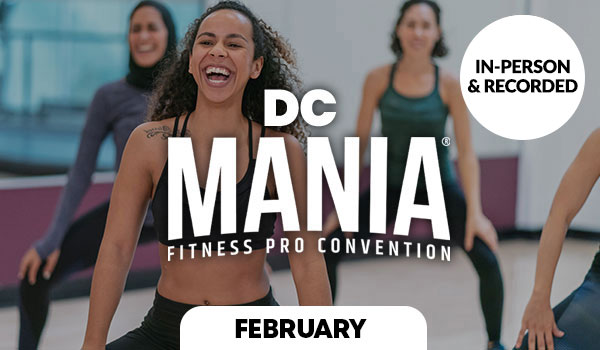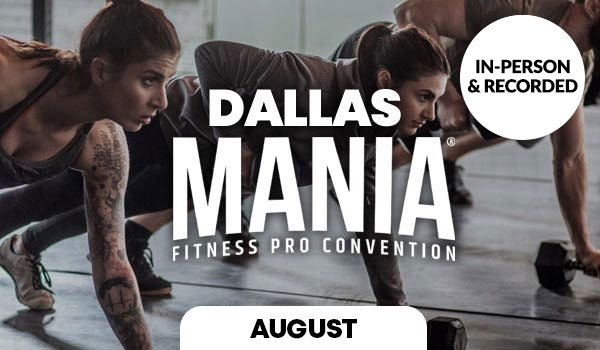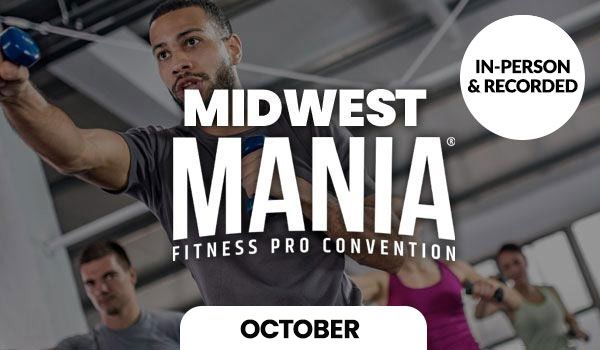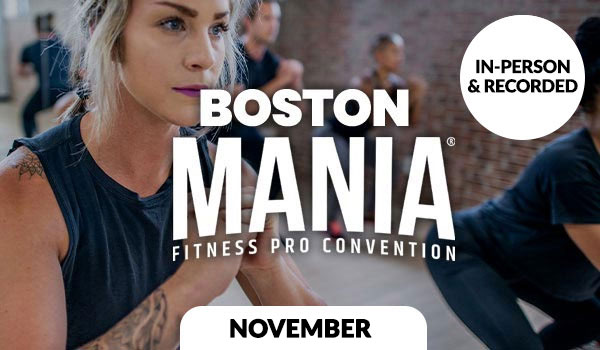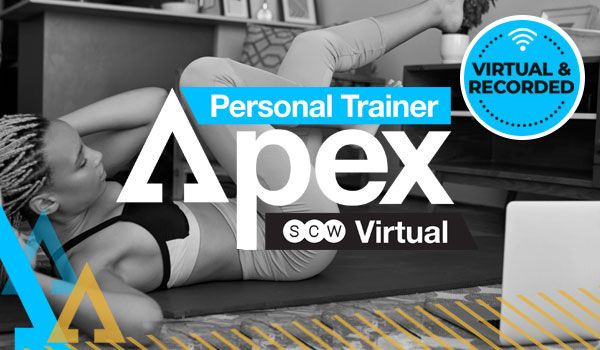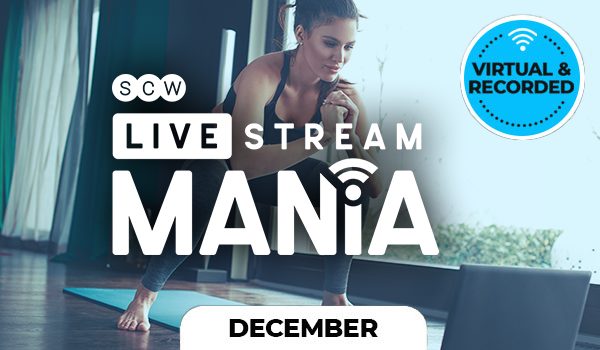
SCW Spotlite: Issue 69

Passion to Purpose: A Lifetime in Fitness Leadership
by Sara Kooperman
Walking the walk
My mission has always been to educate and elevate others in their pursuit of a successful and fulfilling fitness career. Since the beginning of my profession, I have encouraged and supported others to help them become presenters, better trainers, more gifted instructors, and successful business owners. I have focused on individuals of all ages, ethnicities, and financial statuses to pursue their goals and passions no matter what obstacles are in their way. Rising from adversity and pivoting at challenges is what I preach and what I do.
Starting with one small studio, failing miserably, and losing all my money, fueled my desire to succeed. I turned the unsuccessful studio into individual workshops where I traveled from studio to studio teaching group exercise instructors how to teach “Chicago Jazz Funk.” These workshops taught instructors how to take high-impact aerobics and turn it into low-impact dance-style programs. Soon after, I expanded into bringing on other instructors wanting to share their various blends of cardio, strength, and flexibility. Soon we evolved into a full-blown Chicago conference.
Developing a convention was an expensive and daunting task. Booking a hotel, scheduling sessions, writing, designing, printing, and mailing brochures, along with contracting over 40 presenters who needed travel, boarding, and food was terrifying. Taking out four credit cards and crossing my fingers daily made this adventure possible. Over several years, we soon had seven regional fitness conferences attracting a total of over 7000 attendees annually. I dedicated myself fully to educating the fitness industry at a grassroots level, knowing that there was and is a need for high quality, regional affordable education and training,
To blend with the conventions, I built a list of over 40 fitness education certifications. By nurturing and encouraging gifted fitness professionals to share their expertise, these talented and generous fitness pros were similarly driven to share their wealth of knowledge with our fitness family.
Over the past 40 years, I have touched the lives of over 200,000 fitness professionals worldwide. For ten of those years, I was the only female agent worldwide (out of 50) for Les Mills International. I handled one of the largest geographic areas on the globe that spanned three time zones. My commitment to education and professionalism is what drives me. Throughout my career, I have often found myself as the only female in the room. Feeling a bit out of place seems to be my natural position but breaking down barriers and supporting others to follow in my lead has always been my mission.
 On a personal note, my business mantra has always been “family first.” Having a 37-year marriage along with four sons has always presented its challenges. Balancing my personal life with my professional career is quite a test. Yet, I am an entrepreneur at my core and in my heart. Growing and nurturing others is what I do. Finding young talent and guiding them both professionally and personally fulfills my soul. Providing the foundations for others to excel is who I am.
On a personal note, my business mantra has always been “family first.” Having a 37-year marriage along with four sons has always presented its challenges. Balancing my personal life with my professional career is quite a test. Yet, I am an entrepreneur at my core and in my heart. Growing and nurturing others is what I do. Finding young talent and guiding them both professionally and personally fulfills my soul. Providing the foundations for others to excel is who I am.
Inspiring others
I have been the CEO of SCW Fitness Education for the past 40 years and have dedicated myself to education that has positively impacted individuals throughout the world. Spurred on by the pandemic, I produced three free webinars a week with the goal of keeping our fitness industry engaged and motivated. Every Tuesday, Thursday, and Sunday our webinars hosted fitness and wellness professionals sharing their expertise, at zero cost to the attendees. No one knew that this pandemic would last two full years and certainly no one knew what the world was going to be like on the other side. Having led over 200 webinars has been one of my most rewarding contributions to the fitness industry.
Never once have my staff or I complained or balked at working late to run these free online programs. These free webinars ran (and still run) without fail. Having started with three webinars a week, we now offer one webinar a month and continue to offer these open forums for individuals from across the world. Addressing the most pressing topics in the industry including social media, virtual training, nutrition strategies, training techniques, financial survival and so much more, with the intent to inform and educate.
Our webinars regularly drew and continue to draw 100-300 attendees with 25% showing up live, another 15% watching the recordings, and over 50% listening to the Podcast. Anyone and everyone can stay connected to the fitness industry through these complementary and open-access educational offerings.
Our largest webinar drew 1,200 attendees and taught fitness professionals nationwide how to apply for a PPP loan during the height of the pandemic amid unimaginable financial uncertainty. Sadly, most group fitness instructors and personal trainers are not paid as employees but are paid as independent contractors. This made it impossible for clubs and studios to collect any governmental funds, and the pandemic made it impossible for fitness facilities to continue to pay teachers and trainers. My husband and I did two webinars focused exclusively on training clubs, instructors, and trainers to secure their governmental support. We published guidelines and instructions. I received hundreds of personal “thank you(s)” for sharing the legal expertise, business guidance, and fitness knowledge that the webinar provided.
Making a difference in the industry
One of my proudest accomplishments has been keeping my entire staff employed during the pandemic. I reduced my salary by 75% and will continue to do so until our live events recover to pre-pandemic levels. My team of operators, designers, and customer service folks always come first. They have and they always will. We are an eclectic band of diverse, energetic, and committed individuals. Our SCW Family stayed together and even excelled during this time empowered by our new live-streaming events.
We successfully ran 19 live-streaming conventions during the 24 months of the pandemic. In March 2020, there were no live-streaming convention programs to purchase or license in the fitness industry. We built our own proprietary live-stream convention program and site. My talented Creative Department, led by Sean Seningen, used our product membership program along with Zoom to build our site. We then trained our staff and presenters on how to use the system. Everyone on my team ran a room during these conventions – even our bookkeeper! We also trained over 70 fitness professionals on how to integrate video, music, and microphones. Countless hours were spent holding training meetings as well as personal one-on-one sessions. This not only benefited SCW and our convention offerings, but also benefited the individual presenters, their online fitness businesses, and the fitness industry at large. We coached longtime supporters of SCW as well as long-time competitors. We truly adopted the “all in this together “mentality during this pandemic. It was heartwarming the way everyone united and supported one another. This selfless contribution to the industry has been one of my most significant impacts to date.
 I am also proud to be the co-founder of WATERinMOTION® a pre-choreographed, quarterly released group exercise aqua program that provides video, music, and choreography every 12 weeks to fitness professionals worldwide. Aqua exercise is not the ‘sexiest’ of fitness offerings and sadly often ignored. Yet, it is important to the growing aging population and provides a supportive family atmosphere for the deconditioned, older, and disabled markets. During the pandemic, to continue support for our WATERinMOTION® Family, S.E.A.T. Fitness (Supported Exercise for Ageless Training) was created. This program was very successful because it expanded the typical chair fitness program providing a land alternative for seniors and those with special needs to continue or start a much-needed wellness program. My commitment to aquatics and active agers has been significant in the fitness industry inspiring other companies to support these growing populations and underserved markets.
I am also proud to be the co-founder of WATERinMOTION® a pre-choreographed, quarterly released group exercise aqua program that provides video, music, and choreography every 12 weeks to fitness professionals worldwide. Aqua exercise is not the ‘sexiest’ of fitness offerings and sadly often ignored. Yet, it is important to the growing aging population and provides a supportive family atmosphere for the deconditioned, older, and disabled markets. During the pandemic, to continue support for our WATERinMOTION® Family, S.E.A.T. Fitness (Supported Exercise for Ageless Training) was created. This program was very successful because it expanded the typical chair fitness program providing a land alternative for seniors and those with special needs to continue or start a much-needed wellness program. My commitment to aquatics and active agers has been significant in the fitness industry inspiring other companies to support these growing populations and underserved markets.
Making a difference in my community
On a personal level, I have worked tirelessly to support our community of fitness professionals in our mission to promote ‘exercise as medicine.’ I have donated countless hours to IHRSA (now the Health & Fitness Association), having been a dedicated member of the Highlights Committee for Facility Standards and the Pandemic Headlights Committee. I also research, promote, and present on the Talks and Takes Monthly IHRSA Talk Show (as the only woman on the panel of four presenters.)
For this talk show, SCW donates our time to create emails, videos, and social media posts to promote this free show that educates the fitness community. This program runs monthly and addresses current topics focused on helping club owners, managers, and directors navigate their businesses during these disruptive times. I stand strong as the only woman on the panel and continually reinforce the value of our Group Fitness and Personal Trainer front-line workers.
Further, I volunteer and appear frequently for and on the Gold’s Gym Franchise Association Conferences and am a proud member of the Gold’s Gym Think Tank volunteering my expertise to help new gym owners in their decision-making. I have also donated time to the CanFitPro Advisory Board and have offered support through the sharing of both successes and failures. Sharing best practices keeps me close to the saying “We are all in this together.” We all need to focus on wellness to unify the fitness and medical communities. I have been honored as an inductee into the National Fitness Hall of Fame on these grounds.
I also volunteer with ACSM to assist with their Communications and Public Information Committee. Having been a supporter of ACSM for decades, serving to assist the growth of this educational body is a privilege. Helping ACSM with its image beyond a university setting to gain acceptance and acknowledgment as a leader in our fitness community is important.
Further, I have presented for countless colleges and universities to inspire young people to pursue careers balancing their personal and professional aspirations. Speaking at my son’s high schools, colleges, and sports teams, promoting the idea of pursuing a career filled with passion and purpose. I have shared expertise at numerous fitness professional events such as IDEA World, CanFitPro, IHRSA (now the Health & Fitness Association, Club Industry, the Athletic Business Conference, Filex, Asia Fitness, and countless other international events. I write and am quoted frequently in industry magazines and publications. I openly share my opinions and experience and am always the first one to share my information and respond to email requests. I see this as my duty to push our industry forward.
Committing to diversity, equity, and inclusion
I was one of the Founding Board Members of the Women In Fitness Association (WIFA) supporting this organization in its beginning stages and assisting in their formation and membership drives. I ran four (4) WIFA Walks, which were called Sisterhood Strides to unify women in the field of fitness: two were at Club Industry, one was at an IDEA Convention, and another was at IHRSA. We reached over 300 women in the industry encouraging them to support WIFA and each other.
 Offering the SCW Michael Scott Scudder Scholarship has fulfilled my goal of never denying anyone education in the fitness industry. www.scwfit.com/scudder Michael was an incredible presenter who shared his wisdom at all of the SCW Fitness Education MANIA® Fitness Professional Conferences and passed away unexpectedly. SCW has received 121 applicants of all levels and expertise to apply for this scholarship. This is a total of $36,300 in scholarships. We have never turned down even one applicant who has applied for this complimentary MANIA® attendance.
Offering the SCW Michael Scott Scudder Scholarship has fulfilled my goal of never denying anyone education in the fitness industry. www.scwfit.com/scudder Michael was an incredible presenter who shared his wisdom at all of the SCW Fitness Education MANIA® Fitness Professional Conferences and passed away unexpectedly. SCW has received 121 applicants of all levels and expertise to apply for this scholarship. This is a total of $36,300 in scholarships. We have never turned down even one applicant who has applied for this complimentary MANIA® attendance.
The SCW Student Scholarship supports College and University students and faculty who wish to attend MANIA®, aspiring to focus on a Fitness and/or Wellness career but do not have the finances to do so. This award also includes a complimentary Live SCW Certification. As this award is only one month old, we have awarded 11 scholarships worth $4,400. www.scwfit.com/student Anyone and everyone who applies is granted this scholarship.
SCW also offers a 3rd scholarship. The Atchara Seesawat Scholarship. Atchara was a close personal friend of mine who had migrated from Thailand in her teenage years and was the Personal Training Director of the Evanston Athletic Club. During the pandemic, Atchara experienced racism because of her heritage but never wavered from her core nature of kindness and tolerance.
To honor the life of Atchara Seesawat, SCW offers a 3-day scholarship to a MANIA® Convention. This award is for a Personal Trainer who is trying to better their client experience and expand their ability to help others but does not have the financial means to attend the conference. www.scwfit.com/atchara To date we have awarded 22 scholarships totaling a value of $6,600. Anyone who applies is given this award.
SCW has been a constant supporter of diversity, equity, and inclusion and has actively pursued and supported applicants through our Diversity Task Force. Gail Bannister-Munn has been extremely supportive in helping SCW find, secure, and help new presenters of all ethnicities and genders. Our diversity campaign has drawn several new presenters into the industry as well as provided leadership to young aspiring fitness professionals who have never had the opportunity to present. We have expanded our presenter diversity from 5% to 18.5% assisting with session description and biography writing, presenting skills, and PowerPoint creations. It has always been my purpose and passion to nurture others to support others to reach their goals.
Here is a link to my awards & articles:
https://sarakooperman.com/publications/
Here is a link to my webinars, podcasts, and talk shows:
https://sarakooperman.com/webinar/
https://sarakooperman.com/talk-shows/
Here is a link to my book:
 About the Author: Sara Kooperman
About the Author: Sara Kooperman
Sara, CEO of SCW Fitness Education, WATERinMOTION® & S.E.A.T., is a visionary leader who has transformed the fitness education community. A successful business owner and advisor, she is a keynote speaker, published author, podcast presenter, and sought-after industry trailblazer. Sara has a unique ability to share her passion and devotion towards fitness education through her humor, enthusiasm, and her effervescent no-nonsense personality. She serves on the Gold’s Gym Think Tank, was a founding board member of the Women in Fitness Association, is on the canfitpro Advisory Council, is a proud inductee into the National Fitness Hall of Fame, and an active member of ACSM. Sara currently served on IHRSA’s Headlight Committees for Facility Standards and is a panelist on the IHRSA’s talk show, Talks & Takes, and has left an indelible mark on the fitness industry.
Follow us on IG: https://www.instagram.com/scwmania/
Like our FB page: https://www.facebook.com/scwmania
Follow us on X: https://twitter.com/scw_mania
Connect with us on LinkedIn: https://www.linkedin.com/company/scwfit/
Follow us on IG:
https://www.instagram.com/scwmania/
Like our FB page:
https://www.facebook.com/scwmania
Follow us on X:
Connect with us on LinkedIn:
Follow us on IG: https://www.instagram.com/scwmania/
Like our FB page: https://www.facebook.com/scwmania
Follow us on X: https://twitter.com/scw_mania
Connect with us on LinkedIn: https://www.linkedin.com/company/scwfit/

Headaches, Memory Loss, and Tech Neck
by Ruston Webb, MS
Let’s dive headfirst (with excellent posture, of course) into a topic that’s literally a pain in the neck for many: Forward Head Posture.
Ah, the Forward Head Posture – or as I like to call it, the “21st Century Nod.” It’s not just your average nuisance; it’s the root of a tree with branches spreading into various health issues. From the classic headache to memory loss that makes you forget why you walked into the room; this posture problem is a silent saboteur of well-being.
Here’s a quick rundown of the top 10 unwanted guests invited by poor posture:
- Headaches that could rival a caffeine withdrawal.
- Restricted blood flow to the brain, because who needs optimal brain function, right?
- Joint pain – because every joint loves extra, unnecessary stress.
- Digestive problems, adding a literal twist to “gut-wrenching.”
- Spinal misalignment, turning your backbone into a question mark.
- Poor circulation – because apparently, your extremities didn’t want that blood anyway.
- Breathing difficulties, because breathing is so overrated.
- A low mood and confidence, turning slouching into a mood.
- Nerve compression, because life wasn’t electrifying enough.
- Memory loss, making you a champion at the “Why did I come here?” game.
So, what’s the game plan for tackling the dreaded Forward Head Posture?
 First up, let’s chat about screen time. Yes, that glowing rectangle of doom that we’re all glued to. Encouraging our clients to take a digital detox is step one. After all, there’s a whole world out there beyond the screen, filled with wonders like…the great outdoors and face-to-face human interaction!
First up, let’s chat about screen time. Yes, that glowing rectangle of doom that we’re all glued to. Encouraging our clients to take a digital detox is step one. After all, there’s a whole world out there beyond the screen, filled with wonders like…the great outdoors and face-to-face human interaction!
Next on the agenda, we’re turning into posture pundits, schooling our clients on the art of not morphing into a question mark while binge-watching, scrolling, or typing away. It’s about sitting pretty, but with purpose.
And now, for the pièce de résistance – beefing up those deep neck flexors and showing the door to the tight party of upper traps, chest, lats, and levators. We’re talking about a mobility makeover that’ll make even the stiffest upper traps do a double take. By injecting some much-needed extension and rotation into the thoracic spine and stabilizing the scapulothoracic joint, we’re setting the stage for a neck so nimble, it could give swans a run for their money.
All this magic? It’s baked right into The Mobility Recipe. Each ingredient of our program is tailored to whip your clients’ posture into shape, turning forward head posture into a thing of the past and ushering in an era of upright radiance. Dive in, and let’s cook up some lasting change together.
The Mobility Recipe programs are here to slice through these issues like a hot knife through butter. Whether you’re looking to become a Certified Mobility Training Specialist, challenge your clients with a 28-Day Mobility Challenge, or offer targeted solutions for Knee, Back, and Shoulder woes, we’ve got the tools you need.
Our programs are the Swiss Army knife in your fitness business toolbox, designed to correct forward head posture and unravel the knot of related problems. Equip yourself and your clients with the power of mobility and watch as the dominoes of discomfort topple.
Ready to elevate your offering and transform lives, one corrected posture at a time? Dive into The Mobility Recipe programs and let’s get the world standing tall, one spine at a time.
We’d love you to experience The Mobility Recipe programs firsthand. Join Ruston at SCW Florida MANIA®, May 3-5, as he leads several interactive workshops throughout the weekend. Register today for 3-days of health & wellness education, reconnect with your favorite SCW presenters, network with hundreds of fitness pros, and of course, take some time to shop the EXPO.
 About the Author: Ruston Webb, MS
About the Author: Ruston Webb, MS
With over 20+ years in the fitness industry, Ruston Webb is a leader in human movement, holding a master’s degree in Kinesiology. He founded The Mobility Recipe, an accredited Mobility Training Specialist Certification course for fitness professionals. He’s the creator of the transformative Knee, Back, and Shoulder Pain Solutions programs enhancing client well-being and performance. Leveraging his expertise as a former college instructor in exercise science, Ruston owned a successful gym for 11 years, solidifying his legacy as a trailblazer in promoting holistic fitness solutions.
Follow us on IG: https://www.instagram.com/scwmania/
Like our FB page: https://www.facebook.com/scwmania
Follow us on X: https://twitter.com/scw_mania
Connect with us on LinkedIn: https://www.linkedin.com/company/scwfit/
Follow us on IG:
https://www.instagram.com/scwmania/
Like our FB page:
https://www.facebook.com/scwmania
Follow us on X:
Connect with us on LinkedIn:

Exercise Intensity Modifications
Ruben Pereyra
As a group exercise instructor, it is essential to offer modifications to accommodate various fitness levels in each class. Whether participants are recovering from an injury, dealing with chronic pain, or just beginning their fitness journey, fitness instructors can create an inclusive atmosphere where every person in the group feels a sense of belonging.
Follow these tips and techniques to make modifications with confidence:
Scan the room: Before beginning your session, it is crucial that you conduct a comprehensive scan of the environment to gain a better understanding of the physical abilities and limitations of your participants. This includes considering their body types, ages, and fitness levels. Doing so, you will be able to customize your instruction and tailor your workout routines to cater to the unique requirements of each individual. By taking the time to scan the environment and assess the individual needs of your participants, you can create a safe and inclusive environment that promotes a productive workout experience for all.
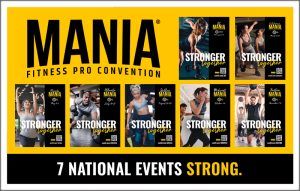 Begin with intention: To ensure that all participants feel comfortable during a fitness session, making it clear before the class that modifications will be available is essential. This way, regardless of their current fitness level or physical abilities, everyone can adjust their exercises as needed to meet their individual needs. Doing this will create an inclusive atmosphere where everyone feels supported and encouraged.
Begin with intention: To ensure that all participants feel comfortable during a fitness session, making it clear before the class that modifications will be available is essential. This way, regardless of their current fitness level or physical abilities, everyone can adjust their exercises as needed to meet their individual needs. Doing this will create an inclusive atmosphere where everyone feels supported and encouraged.
Layer exercises: When leading exercise sessions for seniors, consider their physical capabilities and limitations. To ensure a safe and effective workout, it is recommended to begin each session with low-impact movements that allow participants to warm up and get familiar with exercise movements. This could include gentle stretches or simple cardio movements such as marching in place.
To cater to a wide range of abilities, providing 1-2 exercise options for each exercise move that individuals can work towards throughout the session is helpful. This approach helps mitigate injury risk and assists those recovering from injuries or participants who are not accustomed to a particular movement.
Layering is a highly effective technique to help seniors gradually build their strength and confidence. It is beneficial for those who are new to exercising or have physical limitations. Layering involves breaking down an exercise into smaller, manageable steps that are easier to perform. This allows seniors to work towards their goals comfortably without feeling overwhelmed or discouraged.
For instance, a chair squat is an excellent exercise to help seniors build their leg muscles and improve their balance. To perform a chair squat, they can start by sitting on a chair with their feet flat on the ground and their hands on their hips. Then, they can slowly stand up by using their arm muscles to reach the floor and gradually push off the chair with their triceps muscles. This step helps them build strength in their upper body and core muscles, which is essential for maintaining good posture.
Once they feel more comfortable, seniors can progress to a full squat with the chair as support. This involves standing up from the chair with their feet shoulder-width apart and their hands on the back of the chair. They can then lower themselves slowly to a seated position on the chair, using their leg muscles to support their weight. This step helps them build their leg muscles and improve their balance further.
Finally, seniors can progress to a full squat without a chair. This involves standing with their feet shoulder-width apart and their hands on their hips. Participants can slowly lower themselves to a seated position and stand up again using their leg muscles. This step helps seniors build their leg muscles and improve their balance even more.
By following this layering technique, your class participants can gradually build their strength and confidence in performing exercises. It allows them to work towards their goals at their own pace and avoid injury or burnout.
 Reduce weight, resistance, and impact: Leading by example is a great way to inspire others to follow in your footsteps. Create an environment that encourages modifications in workout routines. These modifications should be enjoyable and helpful in exploring various intensity levels. It is important to emphasize that modifying a workout does not make it less effective.
Reduce weight, resistance, and impact: Leading by example is a great way to inspire others to follow in your footsteps. Create an environment that encourages modifications in workout routines. These modifications should be enjoyable and helpful in exploring various intensity levels. It is important to emphasize that modifying a workout does not make it less effective.
When using weights, it is crucial to instruct the class to go lighter to reduce tension and minimize the risk of injury. Additionally, to ensure joint health during physical activity, participants should take measures to reduce the impact on their joints. By implementing these modifications, participants can continue to engage in physical activity while reducing the risk of joint injury.
Remind participants to take their time with modifications, allowing them enough time to comprehend the exercise and make further changes suitable for their bodies. This will ensure they can get the most out of their workout while staying safe and avoiding potential injuries.
Inclusive and achievable modifications are necessary to allow individuals to attain their maximum fitness potential. Instructors must have the flexibility to adjust to any group to guarantee the safety of all participants. By offering substantial motivational cues and utilizing layering techniques, every group fitness instructor can lead a successful class tailored to suit the needs and abilities of all body types.
 About the Author: Ruben Pereyra
About the Author: Ruben Pereyra
Ruben Pereyra is the Senior Fitness Director at WESELEY Senior Homes in Des Moines. He has his BS, ACE personal trainer, and is a Senior Fitness Specialist, WA Certified Coach, and Speaker Specializing in Senior Populations. For 16 years, Ruben has been a driving force in the fitness industry educating people on the importance of movement and how it can change people’s lives. Ruben is an entrepreneur with services that support every age demographic including personal training, group exercise classes, brain cognitive function training, and being a fitness director for schools, and well-known corporations.
Follow us on IG: https://www.instagram.com/scwmania/
Like our FB page: https://www.facebook.com/scwmania
Follow us on X: https://twitter.com/scw_mania
Connect with us on LinkedIn: https://www.linkedin.com/company/scwfit/
Follow us on IG:
https://www.instagram.com/scwmania/
Like our FB page:
https://www.facebook.com/scwmania
Follow us on X:
Connect with us on LinkedIn:

Fix Gluteal Amnesia in Less than 5 Minutes
by Dr. Meredith Butulis
Your clients are doing hip bridges, squats and lunges. Your clients are committed; they show up; they do the work; they progress loads, yet something is off. They never “feel” their glutes fire; they get stuck on plateaus; when you push plateaus by adding load, they compensate.
As a fitness professional, you read about gluteal amnesia and learn that chronic sitting keeps shutting down the glutes. Your clients take your advice and sit less. Some get standing desks; some take walking breaks; some even add stair climbing through the day.
The problem of sleepy glutes that just won’t fire still persists, though. Over time, the problem gets worst. Low back and sacroiliac pain show up, workout fatigue increases and training progress starts to decline.
How do we fix such gluteal amnesia? The most common fix is surprisingly simple, but often overlooked.
What’s the Fix?
The fix is often following a 4-step pre-workout sequence. The sequence takes less than 5 minutes. The key to making it work is don’t skip steps.
Step 1: Remove arthrogenic inhibition
Step 1 is the critical step that most fitness professionals overlook.
How: Have your client perform what physical therapists refer to as the “shotgun” technique.
Follow these steps:
- Have the client lie on his back with hips and knees bent close to 90 degrees, as if they were going to perform a hip bridge.
- Place a small squishy ball (like Pilates ball or kid’s kickball) between the client’s knees. Have them moderately squeeze the ball for 30 seconds.
- Before letting the ball go, have them quickly push their knees into the ball and then release.
Why it works: Muscles are the outer layer surrounding joints. Both muscles and joints respond to a shared set of nerves. When the inner parts of a joint lack roll, spin or glide due to chronic postures, compensations or injuries, they send faulty signals to the spinal cord. Faulty input creates faulty output. “Shotgun” is one of the first line techniques to reset the hip joint region input-output reflex loop; this reset allows the gluteal motor neurons to fire with more excitement.
 Step 2: Inhibit the antagonists
Step 2: Inhibit the antagonists
Step 2 is commonly misunderstood. The effect comes from holding a trigger point, not continuously rolling over it.
How: Self trigger point release
- Have the client roll their hip flexors and adductors on a roller or ball to scan for tender spots.
- Have the client stop on a tender spot and melt their body weight into the tension for 30 seconds. The release only works if you coach the client in breathing and relaxing into the spot, as opposed to pushing hard into it.
- Repeat for 2-3 additional spots on each side. Note that spots can be different on the right and left, and their location may shift from day to day.
Why it works: Muscles work in agonist-antagonist pairs. Agonists are the prime movers; in this case the gluteus maximus. Antagonists are the muscles on the opposite side of the joint. In the gluteus maximus’ case, the hip flexor and adductor muscle groups are antagonists. When antagonist muscles develop areas of increased neurological tone due to continued postures and repetitious movements, they cannot properly lengthen. When these muscles cannot properly lengthen, they alter the nervous system input. Faulty input leads to faulty output in both the agonist and its antagonists.
Performing self trigger point release to tender spots in the hip flexor and adductor complex activates the golgi tendon organs by temporarily deforming the muscle into a slow small stretch. The golgi tendon organs signal the involved muscles to relax. This helps normalize their ability to lengthen, which normalizes the nervous system input and output. It is like the leash that was holding the gluteal firing back has been released.
Will a massage gun work instead? Maybe. The vibration does temporarily deform the muscle tissue to signal the golgi tendon organ relaxation response. Higher frequencies, such as the vibration versus continuously holding a spot, may facilitate instead of inhibiting. The only way to know if it works for your client is by trying it, as individual responses may vary.
Step 3: Activate the glutes
Step 3 is commonly confused with resistance training, or compound movements like squats.
How: Activation
- Pick a common isolated hip extension exercise such as glute kickback on all fours, or hip thrust exercise with shoulders on the bench. Do not add weight.
- Have the client perform 10 reps of the exercise; instead of cueing for time under tension, cue the client to completely reset and think about squeezing the glutes prior to initiating each repetition. If the client is already in motion, the synergists are already substituting for the gluteus maximus. Resetting each rep minimizes such compensation.
Why it works: This internal cueing to feel gluteal sensation combined with a reset before each repetition allows the client to re-establish conscious awareness of proper muscle firing sensations. Loading the movement, or selecting a compound movement will shield the gluteals from re-establishing this nervous system connection. When this step is skipped, the substituting muscles get stronger, and the glutes continue to be shielded from making effective contributions.
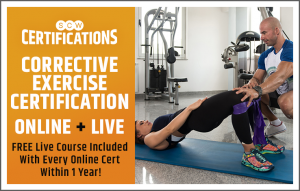 Step 4: Include a potentiation set
Step 4: Include a potentiation set
When clients perform a general warm-up, they often skip the potentiation set for major lifts. Skipping this step bypasses the critical connection needed for effective gluteal contribution in compound lifts.
How: Potentiate
- Perform each desired lift (i.e. back squat, front squat, sumo squat, lunge, deadlift, etc.) at 50% of the intended working weight for one set of 8-10 repetitions.
How it works: The potentiation set creates proper muscle fiber recruitment and motor unit synchronization to orchestrate the correct activation and timing for each muscle to participate. This step does not replace the previous three steps, but rather serves to link all of the preparatory components together for compound movements with less compensation. Less compensation provides an opportunity for the glutes to contribute a new level of activation.
Next Steps
Help your clients fix their gluteal amnesia by including these four steps (in order) as part of their warm-up sequence.
If you find that the client’s gluteal amnesia persists, have the client consult with an allied health provider (such as a Physical Therapist, Chiropractor or Medical Massage Therapist) to identify and further target his unique source of arthrogenic inhibition. Removing the arthrogenic inhibition is like having the correct keys for a car. The glutes will only fire if they have the opportunity to get started.
![]()
 Article courtesy of fit-pro.com
Article courtesy of fit-pro.com
About the Author: Dr. Meredith Butulis
Dr. Meredith Butulis, DPT, OCS, CEP, CSCS, CPT, PES, CES, BCS, Pilates-certified, Yoga-certified, has been working in the fitness and rehabilitation fields since 1998. She is the creator of the Fitness Comeback Coaching Certification, author of the Mobility | Stability Equation series, Host of the “Fitness Comeback Coaching Podcast,” and Assistant Professor the State College of Florida. She shares her background to help us reflect on our professional fitness practices from new perspectives that can help us all grow together in the industry. Instagram: @Dr.MeredithButulis.
Follow us on IG: https://www.instagram.com/scwmania/
Like our FB page: https://www.facebook.com/scwmania
Follow us on X: https://twitter.com/scw_mania
Connect with us on LinkedIn: https://www.linkedin.com/company/scwfit/
Follow us on IG:
https://www.instagram.com/scwmania/
Like our FB page:
https://www.facebook.com/scwmania
Follow us on X:
Connect with us on LinkedIn:

Get Kickin’ Everywhere
by Elizabeth Mooney
It is easy to find yourself in a “rut” as a fitness instructor. Your certifications can land you many jobs at local gyms and fitness centers, however, you can only earn so much money at these types of facilities. In addition, if you live in a small, rural community, traditional options may be limited.
It’s time to think outside the fitness box. Do you like country music? Do you like line dancing? Enter Country Fusion®, a fitness workout that incorporates the twang of country music and steps of line dance to create a kickin’ experience of fun for all levels. Country Fusion® creates a whole new lifestyle and all kinds of new opportunities for its participants, members, and instructors. No need to fear if you lack any dance skills. Most of Country Fusion® choreography is actual line dances. Not only can these dances get your heart pumping at the fitness studio, but many are recognizable in the Honky Tonks. Country Fusion® capitalizes on this unique aspect in a way many fitness instructors see as a lifestyle that helps when they go to learn it.
In June 2022, we proudly opened our Country Fusion Headquarters in “Music City”, Nashville, TN and have expanded to teach the art of line dancing fitness at bachelorette parties and with tourists from all over the world. It is where sneakers and water bottles meet whiskey and cowboy boots. What you learn in the class you take to the Honky Tonk at night!
We are excited to announce the launch of Country Fusion® Aquatics Fitness Program and Country Fusion® Aquatics Instructor Certification. This new addition is not only kickin’ but splashin’ too. Take your line-dancing skills to the pool. The water is beneficial to your joints and helps strengthen the muscles. This opens up new opportunities not only in the gym but at birthday and pool parties as well.
 Country Fusion® is not only fun but also beneficial for your overall health! Dancing provides a full-body workout that’s good for your heart and body. Learning actual line dances works the brain as well and allows you to escape the daily grind and replace it with the music and dance steps. Your brain is a muscle and is constantly stimulated through the dances which could lead to preventing dementia and Alzheimer’s disease. If those benefits aren’t enough, it’s also a lifestyle. What you learn in class you take to the country western clubs, to country music concerts, to buy cowboy boots, and meet friends. Lastly, Country Fusion® is good for your soul. The dances, music, smiles, and positive energy are life changing. No matter what you are going through in life, when you come to class you are present in the moment, which allows you to relax and enjoy yourself.
Country Fusion® is not only fun but also beneficial for your overall health! Dancing provides a full-body workout that’s good for your heart and body. Learning actual line dances works the brain as well and allows you to escape the daily grind and replace it with the music and dance steps. Your brain is a muscle and is constantly stimulated through the dances which could lead to preventing dementia and Alzheimer’s disease. If those benefits aren’t enough, it’s also a lifestyle. What you learn in class you take to the country western clubs, to country music concerts, to buy cowboy boots, and meet friends. Lastly, Country Fusion® is good for your soul. The dances, music, smiles, and positive energy are life changing. No matter what you are going through in life, when you come to class you are present in the moment, which allows you to relax and enjoy yourself.
Opportunities are endless, which leads to earning more money. “Star Instructors” can be hired to teach line dancing at private parties for birthdays, holidays, showers, school dances, and even after-school programs for students and staff. Country Fusion® Pros can get involved in charity events with a country band or have a country theme. Some instructors have participated in events at breweries, wineries, liquor tastings, and stores that sell country wares. More income can be found at corporate parties and wellness programs which are eager to include workouts like Country Fusion® for their employees.
The most common way Country Fusion® “Star Instructors” make money is at bars and restaurants. Certified Professionals establish themselves at a local fitness center and then encourage those clients to attend a nighttime event at a local eatery. Sneakers are traded for cowboy boots, and everyone hits the dance floor! Participants are prepared since most of the dances are learned in fitness classes. Being visible at these nightlife venues attracts new people into the gyms to partake in County Fusion® once they see how fun it is!
The interests and needs of its members and participants are a number one priority. Depending on the location, choreography can be adjusted for the level of the participant. For example, Active Aging Facilities host fitness events with Country Fusion®. The Pro instructors modify their line dances for the senior population. Many members want to practice and build their confidence with line dancing before coming to class, so an online tutorial Country Fusion® program is available.
Country Fusion® has become the leading example of how instructors can get out of the gym and into the pool. The brand has set itself apart by being both a day out at the gym with your sneakers and a night at the Honky Tonks with your cowboy boots!
If you’d like to experience Country Fusion® Aquatics, join Elizabeth at SCW Florida, May 3-5 & Atlanta, July 19-21 MANIA®. She’s launching her latest addition in the pool at the Caribe Royale Orlando. This fun-filled educational weekend pulls out all the stops with over 70 star fitness presenters and 200 sessions. Get registered today.
Follow us on IG: https://www.instagram.com/scwmania/
Like our FB page: https://www.facebook.com/scwmania
Follow us on X: https://twitter.com/scw_mania
Connect with us on LinkedIn: https://www.linkedin.com/company/scwfit/
Follow us on IG:
https://www.instagram.com/scwmania/
Like our FB page:
https://www.facebook.com/scwmania
Follow us on X:
Connect with us on LinkedIn:
 About the Author: Elizabeth Mooney
About the Author: Elizabeth Mooney
Country Fusion® was created and founded by Elizabeth Mooney. Elizabeth has been a dancer since the age of 2 and has taught fitness for over 10 years now. She has produced and directed her Off-Broadway show and has owned her dance studio in NY. She recently moved to Nashville, TN, where she now resides, and has opened Country Fusion® Headquarters. Founder of Burlesque Booty Camp as well as Country Fusion®, Elizabeth is a successful Entrepreneur with instructors all over the world teaching Country Fusion, a professional dancer, choreographer, and highly experienced dance instructor. You can catch her dance choreography with some of today’s top Country Artists and dancing on Broadway in Nashville.
www.countryfusion.net
Facebook: www.facebook.com/countryfusionllc
Instagram: @countryfusionllc
TikTok: @countryfusion

Staying in Your Own Lane: Nutritional Tips for Coaching Clients
by Amber Toole
As fitness professionals, our clients often look to us for guidance not only in the gym but also in the kitchen. Nutrition plays a pivotal role in achieving health and fitness goals, making it essential for us to understand our scope of practice when offering dietary advice. In this article, we’ll explore the boundaries of what personal trainers can do as nutrition coaches, how it varies across states, potential legal liabilities, and the distinctions between our role and that of a registered dietitian.
Understanding the scope of practice is crucial to ensure we provide effective and safe guidance to our clients. Without proper qualifications and knowledge, we risk overstepping boundaries and potentially causing harm. That’s why obtaining a legitimate nutrition coaching certification is strongly recommended. It not only enhances our expertise but also demonstrates our commitment to professional development and client well-being.
However, even with a certification, it’s important to recognize that the guidelines for nutrition coaching may differ depending on the certifying body and the state in which you coach. While some organizations may allow fitness professionals to offer general dietary advice and healthy eating tips, others may have stricter limitations or require additional credentials.
Before delving into nutrition coaching, it’s crucial to check with your certifying body to understand its stance on the role of fitness professionals in nutrition guidance. Familiarize yourself with any codes of conduct or guidelines they provide to ensure compliance and ethical practice.
In addition to certification and organizational guidelines, it’s essential to be aware of legal considerations when offering nutrition advice. Personal Trainers could face potential lawsuits if they provide inaccurate or inappropriate dietary recommendations that result in harm to clients. This emphasizes the importance of staying within our scope of practice and referring clients to registered dietitians or other qualified professionals when necessary.
Such a lawsuit occurred in 2022 when Brittany Dawn Davis, a fitness influencer, was accused of deceptive practices related to personalized fitness and nutrition plans. She ended up settling with a $400,000 payment in civil penalties and restitution. It was stated that her nutrition plans misled her followers with eating disorders and potentially caused them harm.
 With nutrition being a large aspect of health improvement, what exactly are personal trainers allowed to do when it comes to nutrition coaching?
With nutrition being a large aspect of health improvement, what exactly are personal trainers allowed to do when it comes to nutrition coaching?
While the specifics may vary, there are generally accepted practices that fall within our scope of practice:
- Providing general nutrition education: Personal trainers can offer basic information on macronutrients, micronutrients, hydration, and the importance of balanced eating. This may include discussing portion control, food choices, and meal timing.
- Offering meal planning guidance: While personal trainers cannot prescribe specific meal plans tailored to individual needs, they can offer general guidance on building balanced meals and snacks. This may involve recommending nutrient-dense foods, emphasizing variety, and encouraging mindful eating habits.
- Supporting behavior change: Personal trainers can help clients set realistic goals, develop healthy eating habits, and overcome barriers to dietary adherence. This may include strategies for meal prep, grocery shopping, and managing cravings.
- Collaborating with other professionals: When clients require specialized dietary advice or have complex health conditions, personal trainers should refer clients to a registered dietitian, physician, or other healthcare providers. This ensures clients receive comprehensive care that aligns with their individual needs and goals.
While personal trainers can offer valuable guidance in nutrition, it’s important to recognize the limitations of our role compared to that of a registered dietitian. Registered dietitians undergo extensive education and training to assess nutritional needs, develop personalized meal plans, and manage medical conditions related to diet. They are qualified to provide individualized nutrition counseling and medical nutrition therapy, which falls outside the scope of practice for most personal trainers.
The key to remember as fitness professionals, is to understand our scope of practice when offering nutrition coaching to clients. By obtaining proper certification, adhering to organizational guidelines, and staying within our areas of expertise, we can provide effective and safe guidance that supports our clients’ health and fitness goals. Collaboration with other healthcare professionals and a commitment to ongoing education further enhance our ability to serve clients effectively.
Craving more nutritional insight, join Amber at SCW Florida MANIA®, May 3-5, boasting 3-days filled with the latest research in over 150 sessions and workshops, including 15 nutrition-focused lectures, and 50+ presenters. See you there.
 About the Author: Amber Toole
About the Author: Amber Toole
Amber Toole is an ACE Certified Personal Trainer with a Bachelor of Science in Physical Education and Health from Georgia Southern University. She has 30 years of experience in the Fitness Industry and loves to share her expertise with other Fitness Professionals. It is her life’s mission to spread the truth about fitness and nutrition through education. She is the owner of The Training Toole – a Fitness and Nutrition Studio in Ocala, Florida, and an SCW Educator and Fit Pro Mentor.
Follow us on IG: https://www.instagram.com/scwmania/
Like our FB page: https://www.facebook.com/scwmania
Follow us on X: https://twitter.com/scw_mania
Connect with us on LinkedIn: https://www.linkedin.com/company/scwfit/
Follow us on IG:
https://www.instagram.com/scwmania/
Like our FB page:
https://www.facebook.com/scwmania
Follow us on X:
Connect with us on LinkedIn:

It’s Tax Time (All the Time)
by Kylie Ross
Even though April 15, the official Tax Day, just passed doesn’t mean “that’s it” until next year. The time is now to analyze how well your fitness business did last year and compare it to progress made so far in order to predict the remaining months of this year for the next tax season.
Here are some questions you may ask:
- Did you waste money?
- Should you have made that investment in a space for classes?
- Should you have expanded your current gym?
This is normal to second guess some decisions you made during the year. All you can do now is move on. Let’s talk about that process….
The 1st quarter of the year is over and the 2023 results for your business are complete. Now it’s time to go through your business wish list. Pick out the top three items you would like to take on this year. With those top three items, add in investment costs for either a consultant or business attorney who can point you in the right direction for those wishes to be successful financially.
Here are nuggets for you to consider:
- If you are looking to expand your current space, please research the market. Start with a Realtor who can point you in the right for your desired location and/or who is knowledgeable of the best locations to consider.
- Have your prior year statements ready for your bank to study and make a pre-approval decision on.
- If you want to begin selling products, seek a consultant, or a trusted colleague that can help with tips on what to avoid. I can tell you from experience that getting a good vendor that ships quickly and gets their money upfront, rather than on the back end, is best. For example, Alibaba gives tax-exempt opportunities to businesses that apply, which saves in cost, and they can attach your logo for advertisement. Faire is another great source for goods that can cater to your needs at a fair cost.
Speaking of advertising, did you advertise your business much last year? Remember, advertising comes in many forms, such as contributions/sponsorships to events for recognition; purchasing a magnet for your vehicle; or purchasing an ad space in a magazine. Advertising is crucial to your business, so much so that can make or break it. A colleague once told me, “Sometimes, you have to pay to play.” That stuck with me and changed my entire mindset towards how I invest in such advertising opportunities.
I asked myself, “If I don’t sell a thing or sign up one person; what will I gain?” If presence draws at least one person to me with follow-up questions, I consider that a win, because you are now a lead for me to keep in touch with, until you realize how much you need to be my client. This is your classic “bait and hook” strategy. In essence, don’t consider advertisement opportunities as something instant; understand that they can come in many forms and may take some time and effort, which can now be automated!
If you’d like to learn more from Kylie, join her at SCW Florida (May 3-5) & Atlanta (July 19-21) MANIA®. She’s offering up the latest information regarding “Your Financial Health” along with over 150 sessions and workshops led by more than 50 recognized presenters providing current research and trending exercise movements.
For more information about VK Professional Services, call or text 678-788-7717, or email us at [email protected] You can also find and follow us on LinkedIn, Facebook, and Instagram.
 About the Author: Kylie Ross
About the Author: Kylie Ross
Kylie Ross is the Owner of VK Professional Services, VRoK Fitness, and a Tax Manager with Turbo Tax. VK Professional Services offers tax planning and preparation, bookkeeping, notary, website design, and business consulting. Kylie Ross is a Certified Personal Trainer from SCW, a Nutrition Coach, and Bariatric Health Expert. She has been in both industries professionally for almost 6 years. She’s been a Gastric Bypass recipient for 11 years, works hard to stay healthy and fit, and now she assists others to prevent obesity-driven conditions via virtual and mobile fitness and nutrition guidance.
Follow us on IG: https://www.instagram.com/scwmania/
Like our FB page: https://www.facebook.com/scwmania
Follow us on X: https://twitter.com/scw_mania
Connect with us on LinkedIn: https://www.linkedin.com/company/scwfit/
Follow us on IG:
https://www.instagram.com/scwmania/
Like our FB page:
https://www.facebook.com/scwmania
Follow us on X:
Connect with us on LinkedIn:
Looking for a New Job? SCW Can Help!
Facilities need you! Whether it’s Teachers, Trainers, Directors, or Managers, SCW’s new FREE JOB BOARD is supporting the industry’s need for qualified fitness pros.
We post openings in all three of our monthly e-newsletters: Spotlite, Health & Fitness Business News, and Tidal Waves which are emailed out to tens of thousands of fitness professionals teaching and training in all formats along with managers and directors at all fitness facilities: big box, gyms, boutique, studios, not for profits and independent centers.
Social Media Assistant
SCW Fitness Education – Remote
This part time virtual Social Media Assistant is responsible for managing the SCW social media for MANIA, WATERinMOTION, SEAT Fitness and Sara Kooperman. This is a 10-20 hour part-time position that is responsible for instagram, facebook, linkedin and tik tok.
Event Tech Specialist (A/V)
SCW Fitness Education – Remote Part Time
Join our SCW MANIA® Fitness Professional Convention team as an Event Tech Specialist! Your role involves efficiently handling equipment for our conventions and setting up A/V gear for sessions, and general troubleshooting during events. We’re looking for someone organized, able to lift heavy equipment, and with basic A/V technical skills. If you’re passionate about event production and A/V setup, apply now for this exciting opportunity to create unforgettable experiences for fitness pros and enthusiasts!
Aqua Fitness Instructor
Midtown Athletic Club – Bannockburn, IL
Midtown is searching for Aqua Fitness Instructors to teach and motivate our members to achieve their goals through classes in the Pool at Midtown!
Must have AM availability.
Aqua Instructor
Central YMCA – Arlington, TX
We are looking for passionate certified aqua instructors for our summer outdoor pool classes. The class schedule begins the end of May and runs through early September and the class times are 7:15a and 8:15a.
Exercise Physiologist
Woman’s Center for Wellness – Baton Rouge, LA
Conducts 1-on-1 and group training exercise sessions with cancer survivors, bone health sufferers, and other related diagnoses. Other duties include exercise testing and evaluation, and the development of appropriate exercise programs. Performs other duties assigned by department management. Must be knowledgeable of exercise standards and guidelines established by the ACSM.
Wellness Specialist
Orange County Sheriff’s Office – Orlando, FL
Functions as a trained subject matter expert in the area of fitness and wellness by developing programming and providing instruction, education, coaching and encouraging individuals to adopt personal healthy lifestyle habits and behaviors by performing the following duties.
Group Exercise Instructor
Woman’s Center for Wellness – Baton Rouge, LA
Candidate will instruct fitness classes, such as Yoga, Indoor Cycling, Aqua, Mat Pilates, Zumba, strength training, etc.
Candidate must have group exercise certification, professional liability insurance and CPR/AED required; specialty certification in Yoga, Indoor Cycling, Aqua, REFIT, HIIT, Mat Pilates, Zumba, strength training and/or circuit preferred.
Group Fitness Instructor
F45 Training Longmont – Longmont, CO
We’re looking for personable & high-energy coaches to deliver a top-notch studio experience for our group training HIIT workouts. The people we’re looking for:
- Have a growth mindset and want to be part of a professional team.
- Thrive in a fast-paced environment.
- Come alive in front of a group!
Assistant Director, Fitness
Leonard J. Kaplan Center for Wellness – UNC Greensboro
The Assistant Director, Fitness is responsible for the overall design, management, and implementation of a comprehensive fitness program for the students, faculty, staff and UNC Greensboro community. This includes leadership of two professional positions and a graduate assistant as well as student employees.
Group Exercise Instructor
Indian Boundary YMCA – Downers Grove, IL
All formats needed. Early morning, morning and evening classes available. Reach out me at the included phone number or email address for more information.
 We’re always looking for great content highlighting the newest things in the world of fitness. Please submit your article directly to [email protected] for immediate consideration!
We’re always looking for great content highlighting the newest things in the world of fitness. Please submit your article directly to [email protected] for immediate consideration! Spotlite, April 26, 2024
Spotlite, March 22, 2024
Spotlite, February 19, 2024
Spotlite, January 20, 2024
Spotlite, December 21, 2023
Spotlite, November 18, 2023
Spotlite, October 22, 2023
Spotlite, September 21, 2023
Spotlite, August 19, 2023
Spotlite, July 19, 2023
Spotlite, June 19, 2023
Spotlite, May 18, 2023
Spotlite, April 21, 2023
Spotlite, March 28, 2023
Spotlite, February 18, 2023
Spotlite, January 21, 2023
Spotlite, December 16, 2022
Spotlite, November 19, 2022
Spotlite, October 22, 2022
Spotlite, September 24, 2022
Spotlite, August 23, 2022
Spotlite, July 22, 2022
Spotlite, June 20, 2022
Spotlite, May 18, 2022
Spotlite, April 20, 2022
Spotlite, March 25, 2022
Spotlite, February 17, 2022
Spotlite, January 14, 2022
Spotlite, December 17, 2021
Spotlite, November 18, 2021
Spotlite, October 25, 2021
Spotlite, September 16, 2021
Spotlite, August 9, 2021
Spotlite, July 10, 2021
Spotlite, June 8, 2021
Spotlite, May 14, 2021
Spotlite, April 30, 2021
Spotlite, March 30, 2021
Spotlite, February 23, 2021
Spotlite, January 20, 2021



